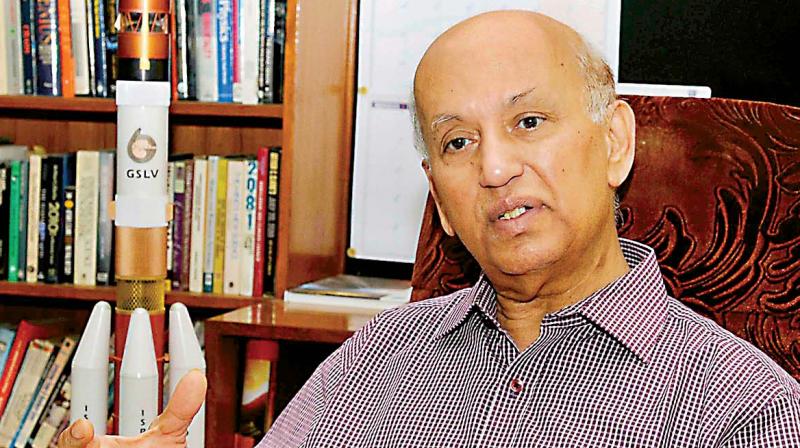Professor UR Rao knew Mars, loved Venus

Brilliant, soft-spoken and yet with a measure of grace and confidence that set the truly great men apart from the ordinary - Prof. U.R. Rao was that rarest of men, a scientist who understood history and culture as much as he did science and space. B. R. Srikanth pays tribute to the man who knew Mars and loved Venus!
He was the only Indian space scientist to be inducted into the Hall of Fame by two global entities-the International Astronautical Federation (IAF) and the Society of Satellite Professionals International: This extraordinary honour sums up best the unparalleled contribution of Prof Udupi Ramachandra Rao, former chairman, Indian Space Research Organisation (ISRO), who played a pivotal role in transforming the space agency into a global major, until just before his demise in Bengaluru on Monday.
Prof Rao, 85, was handpicked by his mentor, the late Dr Vikram Sarabhai, the father of India's space endeavour, to shape the satellite technology programme in 1971. Prof. Rao not only piloted the design, fabrication and manufacture of more than 20 satellites beginning with the country's first satellite, Aryabhata, in 1975 but was equally instrumental in promoting the application of space technology for broadcasting, meteorology, disaster warning, remote sensing and education.
Some of his pioneering efforts in application of space technology helped usher in the concept of integrated management of natural resources for sustainable development.
While he accelerated development of rocket technology simultaneously, the physicist in him made sure that he left an imprint even on recent missions to Moon (Chandrayaan-I) and Mars (Mars Orbiter Mission) by picking instruments best-suited for indigenous studies.
In short, he steered ISRO through its long journey from a bullock cart test-ride for APPLE satellite in 1981 to Mars a couple of years ago. His last and latest recommendation as Chairman of Advisory Committee for Space Science (ADCOS): an outing to Venus, the brightest and hottest planet of the solar system, to understand the evolution of the world.
Acknowledged the world over
Globally he was acknowledged for his expertise and co-authored papers with the likes of the late Sir Arthur Clarke and served in various capacities as Chairman of the United Nations Committee on Peaceful Uses of Outer Space (UN-COPUOS), Chairman of UNISPACE-III Conference and Chairman of the 30th International Antarctic Treaty Consultative Committee Meeting in New Delhi in 2007. He also had a role in design and development of instruments for NASA's Pioneer and Explorer satellites during his stint in MIT where he collaborated with a team from Jet Propulsion Laboratory (JPL), Pasadena.
Guide and mentor
"He was a scientist-administrator who pursued his interest in X-ray astronomy and atmospheric Physics as he rose in his career and guided a number of students on research projects and papers," reminisced Dr R Aravamudan, former director of ISRO's Satellite Centre (ISAC), Bengaluru, a facility set up by Prof Rao for design and manufacture of satellites.
The perfectionist
Prof Rao was a perfectionist who wanted everything to be completed quickly according to Dr A S Kiran Kumar, Chairman, ISRO. "At times, he wanted to do things all by himself. I remember that he picked up the soldering rod to fix a glitch which was discovered before the launch of Bhaskara satellite in erstwhile Soviet Union," he told Deccan Chronicle.
Published 360 papers
His decade long stint as Chairman of ISRO did not deter him from publishing more than 360 scientific and technical papers in national and international journals on cosmic rays, interplanetary physics, high energy astrophysics, space applications and satellite and rocket technology. He also authored many books, including "Physics of the Communication", "Space and Agenda 21 - Caring for the Planet Earth" and "Space Technology for Sustainable Development".
From garage to Galaxy
Prof Rao, who put together a team of scientists and engineers to commence work on the satellite programme in a tin shed in Peenya Industrial Area in 1970s, also employed a novel technique to test whether APPLE satellite could endure electromagnetic interference: A bullock cart was used to move the satellite around during the test.
A crucial test during his decade-long tenure as Chairman, ISRO, came when some powerful bureaucrats in New Delhi suggested to the late Prime Minister Mr Rajiv Gandhi that ISRO's headquarters should be moved to New Delhi.
"I told Mr Gandhi that I will rather quit than allow the headquarters to be moved to Delhi because our satellites are built in Bengaluru, and most experts are here in IISc, NAL and HAL. He said that's not necessary and allowed us to continue here," he told this newspaper during a recent interview.
Explaining the universe
Prof Rao steered ISRO through its long journey from a bullock cart test-ride for APPLE satellite in 1981 to Mars a couple of years ago. His last and latest recommendation as Chairman of the Advisory Committee for Space Science (ADCOS) - an outing to Venus, the brightest and hottest planet of the solar system, to understand the evolution of the world.
Man of steel opposed flyover
He was equally candid when Karnataka Chief Minister Siddaramaiah shared his plans to build a steel flyover that would have blocked the views from the Nehru Planetarium of the sky and the space that he had put his imprint on. Wagging his finger at the chief minister he said " the children who come to the planetarium cannot be deprived of views of the skies, I cannot let that happen."

